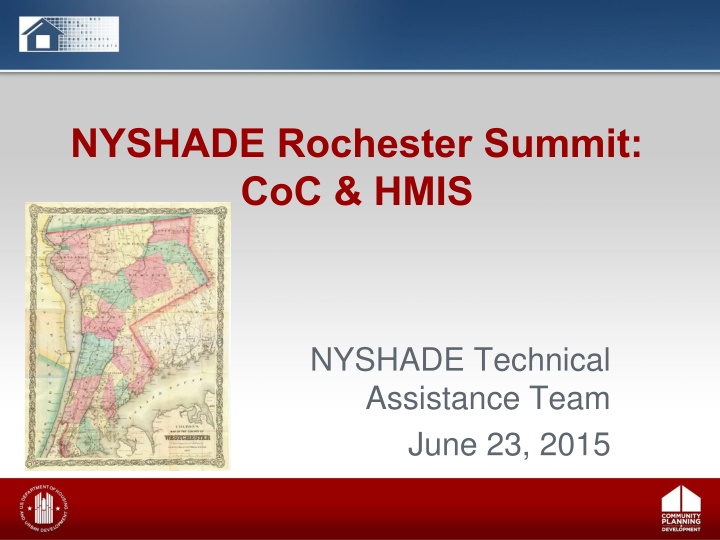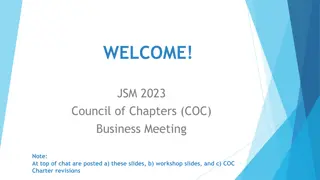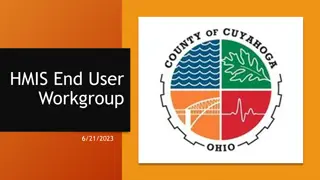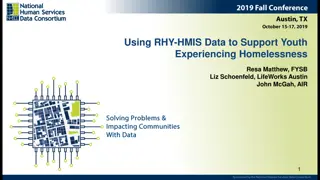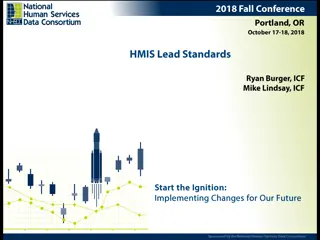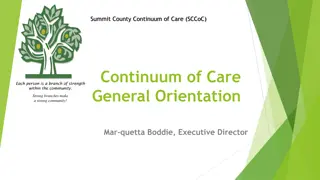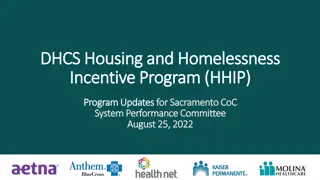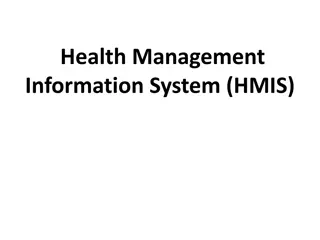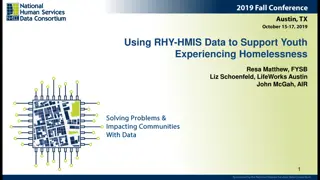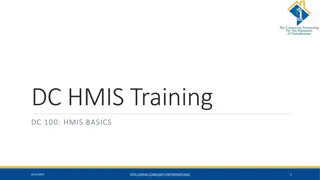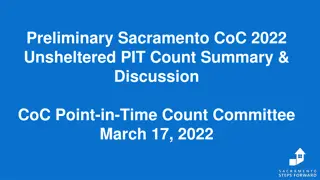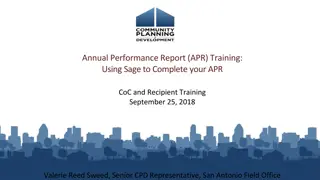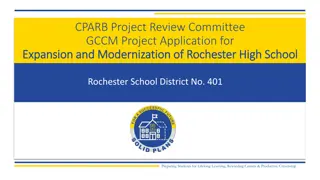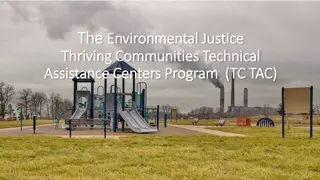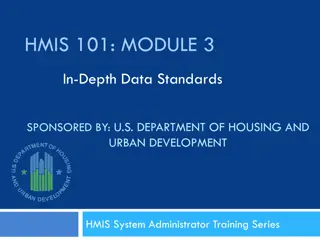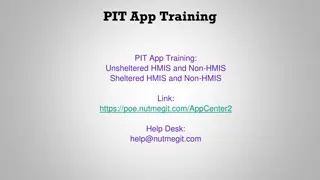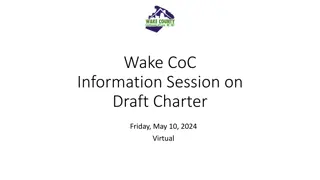NYSHADE Rochester Summit: CoC & HMIS NYSHADE Technical Assistance Team
NYSHADE Rochester Summit: CoC & HMIS NYSHADE Technical Assistance Team gathered on June 23, 2015, to discuss topics including project phases, data uploads, data quality assessment, and policies for HMIS data. The team will focus on engaging local HMIS implementations, improving data collection processes, and ensuring comprehensive data representation for STEHP grantees. OTDA will lead the continued development of NYSHADE, working closely with recipients to implement Phase I by July 20, 2015.
Download Presentation

Please find below an Image/Link to download the presentation.
The content on the website is provided AS IS for your information and personal use only. It may not be sold, licensed, or shared on other websites without obtaining consent from the author.If you encounter any issues during the download, it is possible that the publisher has removed the file from their server.
You are allowed to download the files provided on this website for personal or commercial use, subject to the condition that they are used lawfully. All files are the property of their respective owners.
The content on the website is provided AS IS for your information and personal use only. It may not be sold, licensed, or shared on other websites without obtaining consent from the author.
E N D
Presentation Transcript
NYSHADE Rochester Summit: CoC & HMIS NYSHADE Technical Assistance Team June 23, 2015
NYSHADE TA Team NYSHADE Team: Caitlin Frumerie, The Cloudburst Group Tony Gardner, Tony Gardner Consulting (Not Present) Madeleine Nagy, Nickel City Consulting (Not Present) Chris Pitcher, ICF International Joel Remigio, The Cloudburst Group
CoC & HMIS Topics Recap of NYSHADE presentation NYSHADE Phase I & II NYSHADE Technical Issues HUD Coordinated Entry Brief New York HMIS Issues HMIS Participation & Local Districts Benefits of Local District Data Collection Role in Coordinated Entry
NYSHADE Recap NYSHADE Phase I data uploads quarterly going forward NYSHADE Phase II begins in later 2015 Will build upon the structure created in Phase I Expand the data set to include all data contained within all New York State HMIS implementations
NYSHADE Recap Will require technical efforts to engage the remaining local HMIS implementations that do not have STEHP funds Assess CSV 4.0 Assess data quality Implement policies and procedures for the extraction, exchange, security, privacy, confidentiality and reporting of the HMIS complete data set
NYSHADE Recap Uploads must represent a full export (contain all .csv files) Date range for records to upload is October 1st 2014 to present Only full refresh accepted (no partial or delta uploads) All Organizations and Projects for STEHP Grantees must be included in the upload (except for DV Projects) Only STEHP Projects accepted in Phase I
NYSHADE Recap OTDA will continue to develop the technical and programmatic aspects of NYSHADE OTDA will work with STEHP recipients to continue implementing Phase I of NYSHADE Data uploads by July 20, 2015 OTDA will continue convening the NYSHADE Workgroup
NYSHADE Recap Establishing MOU for Phase II Continue developing reports Identify training needs for agencies Create communication plan for relevant agencies
NYSHADE Recap NYSHADE Technical Issues: How is PPI Converter and Maintained One way street: There is no way to pull the PPI out of the lockbox PPI only function for NYSHADE is to generate a Token Token generated cannot be linked back to PPI within the lockbox
NYSHADE Recap Exporting of HMIS Data to NY State and the Upload Interface Standard file Upload Dialog Box which allows users to choose file right from the PC User will be able to see all previous uploads when logging into the interface. Uploads must represent a full export regardless of whether all the individuals files contain data. 11
NYSHADE Recap Exporting of HMIS Data to NY State and the Upload Interface Only full refresh accepted at this time in order to allow the warehouse to do a complete re-write of records. Average 4 minutes to lock and delete records after uploads Uploaded File Verification Zip file contents checked to see if export.csv exists. If not file is rejected. If so, then the zip file is also checked for correct formatting. 12
NYSHADE Recap Validation All validations are against HUD HMIS CSV 4.0 Entire validation stops if a single file threshold is exceeded. Data quality is critical-if one file has an error most of the other files will also have errors due to the relationship of each of the files. 13
NYSHADE Recap Consents Implementing consistent client consent language Has your agency thought about how you are going to train your staff on the NYSHDAE efforts? 14
HUD Coordinated Entry Policy Brief HUD Coordinated Entry Policy Brief Coordinated Entry Policy Brief Released in February 2015 Describes HUD s views of the characteristics of an effective Coordinated Entry Process Does not establish CoC requirements, but is meant to inform local efforts to further develop Coordinated Entry Processes 16
HUD Coordinated Entry Policy Brief Primary Goals of Coordinated Entry Processes: Assistance be allocated as effectively as possible That it be easily accessible no matter where or how people present 17
CoC Program Rule CoC Program Interim Rule: 24 CFR 578.7(a)(8) CoC must establish a centralized or coordinated process designed to coordinate program participant intake, assessment, and provision of referrals. A centralized or coordinated entry process: Covers the geographic area Is easily accessed by individuals and families seeking housing or services Is well advertised and Includes a comprehensive and standardized assessment tool 18
Coordinated Entry Qualities Referral Protocols Outreach Ongoing Planning & Stakeholder Consultation Informing Local Planning Leverage Local Attributes & Capacity Safety Planning Using HMIS and other systems for coordinated entry Full Coverage Prioritization Low Barrier Housing-First Orientation Person-Centered Fair and Equal Access Emergency Services Standardized Access & Assessment Inclusive Referral to Projects 19
Prioritization A main purpose of Coordinated Entry is to ensure that people with the most severe service needs and levels of vulnerability are prioritized for housing and homeless assistance Chronic Homelessness: Notice CPD-014-12 Factors for Vulnerability/Severe Service Needs: Significant health, behavioral health challenges or functional impairments High utilization of crisis or emergency services The extent to which people are unsheltered Vulnerability to illness or death Risk of continued homelessness Vulnerability to victimization 20
Prioritization Use all available data and research to inform prioritization decisions If a person is assessed as highly vulnerable but no PSH is available, the person should be prioritized for other types of assistance (TH, RRH). Be aware of eligibility impacts when placing someone in TH (CH status, RRH) 21
Wait Times Long wait times make homeless assistance less effective and reduce the overall performance of a community s homeless assistance system Short wait times of a few days or weeks might be necessary to properly manage utilization, but wait times of several months or years should be eliminated whenever possible Most communities face a gap between need and availability based on limited resources Get creative when possible 22
Effective Assessment Tools Principles That Ensure Effective Tool & Procedures: Phased Assessment Necessary Information Participant Autonomy Person-Centered Cultural Competence User-Friendly Privacy Protections Meaningful Recommendations Written Standards, Policies & Procedures Sensitive to Lived Experience 23
Integrating Youth Consider whether youth are better served with separate access points Where do homeless youth feel comfortable and safe? Are staff available who specialize in working with youth? If youth access separate entrance points, how are we ensuring they can still access assistance from other parts of the homeless system? 24
Survivors of Domestic Violence Ensure the Coordinated Entry process address the safety needs of people fleeing domestic violence Is there a safe location/process for conducting assessments? Is there a process to provide confidential referrals? Is the data collection process consistent with VAWA? If a survivor accesses a separate DV entrance point, how are we ensuring they can still access assistance from other parts of the homeless system? 25
Defining Roles Homeless Assistance Organizations Emergency shelter, TH, RRH, and PSH programs should only receive referrals through the Coordinated Entry Process Mainstream Housing & Services Can act as a source or receiver of referrals, and co-location of services with a physical or virtual access point is an option Prevention & Diversion At a minimum, ESG funded prevention assistance should be incorporated into Coordinated Entry Process 26
Future HUD Guidance Summer 2015: Notice on the requirements for development and implementation of a CoC Coordinated Entry Process Ongoing:TA products including special considerations for youth and people fleeing DV, compliance & monitoring, funding CE, data sharing sample CoC written standards 2015: ESG and CoC Program interim rules will be released for public comment 27
Resources HUD: Office of Policy Development & Research February 2015 Summary Report: Assessment Tools for Allocating Homelessness Assistance: State of the Evidence Requirements for a Centralized or Coordinated Assessment System in CoC Program Interim Rule Office of Special Needs Assistance Programs (SNAPS) July 2013 Weekly Focus on Coordinated Assessment Overview of Coordinated Assessment Systems Prezi and Video 28
Resources Community Solutions: Overview of Coordinated Assessment and Housing Placement System and CAHP System Overview - Zero: 2016 Corporation for Supportive Housing: January 2015 Report: Improving Community-wide Targeting of Supportive Housing to End Chronic Homelessness National Alliance to End Homelessness: Coordinated Assessment Toolkit USICH:Coordinated Assessment: Putting the Key Pieces in Place 29
Coordinated Entry Activity Coordinated Entry Activity Read the handout provided with your team Answer the questions together as a group and designate someone to report back We will then regroup and discuss everyone s answers and experiences 30
Vendor Relations All 3 vendors should be able to export FULL exports not just the .CSV files for SSVF OTDA/ITS needs to be informed when vendors implement software patches and bug fixes so that we can anticipate upload problems
Project Descriptor Data Elements Administrators should ensure that all Organizations, Projects, and Project Types match the list provided by OTDA. Providers should be filling in the site information for their organization (including Geocode). 33
UDE Data Quality Providers need to ensure all clients have their Race and Veteran s status filled in. Providers should be filling in Prior residence and Exit Destination since there are codes for unknown, other, doesn t know . These fields are used for some of our reports. 34
Communication Providers and administrators are encouraged to respond to validation corrections in a timely manner. All administrators should choose and provide the information for the 2 staff members responsible for the HMIS uploads. 35
HMIS Participation & Local Districts HMIS Participation & Local Districts Local Districts provide services to those at risk of or experiencing homelessness Rural Local Districts often provide the only emergency shelter services through hotel/motel placements Data collection by Local Districts is inconsistent statewide
HMIS Participation & Local Districts The Conundrum: Local District data is key to fully understanding the nature and scope of homelessness Local District have existing data collection systems The State of New York has not required Local District Participation, only strongly encouraged
HMIS Participation & Local Districts The Changing Landscape: HMIS Participation historically has been about required funding sources HEARTH, Coordinated Entry and Federal Partners have changed HMIS participation Coordinated, client-centric care requires comprehensive data sets including Local Districts
HMIS Participation & Local Districts Local District Benefits: HMIS Participation established formal connection with CoC, Coordinated Entry Effective, Coordinated Services can lead to less Local District funds for homeless services Involvement in the CoC will establish community-wide connections with mission- similar organizations
HMIS Participation & Local Districts Local District Benefits: HUD s focus on the hardest to serve clients will help house Local Districts long term homeless Develop a role for Local Districts in ending veteran homelessness and chronic homelessness Improve local homeless service delivery
HMIS Participation & Local Districts Local Districts Activity: What has worked in communities that have integrated Local Districts into HMIS? What challenges are there in engaging Local Districts? Community Best Practices?
Questions Questions?
